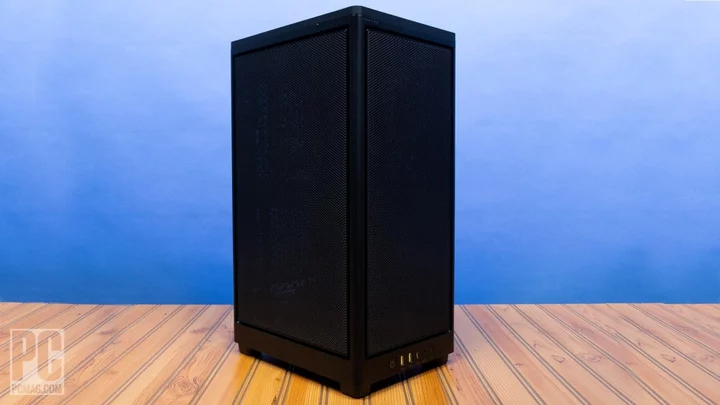More than a dozen years have passed since one of Corsair’s competitors turned the reduced-profile gaming-cube PC case on its face, but we’ve never seen it done quite like this. The $199.99 2000D RGB Airflow flips most of its components onto their edges, while still retaining the vertical graphics card space for which this type of case is known. It’s quite the performer, as you will see in our tests. To be sure, the pricing seems a tad high for the materials, and you’ll need patience with the cable work. But as long as you can stomach the cost and some possible fan noise under load, it can be the basis of a stellar-looking—and super-cooling—small-form-factor PC build for Mini-ITX.
The Design: Small Footprint, Flipped
A footprint of only 7.9 by 10.7 inches—far less than a foot square—puts the 2000D RGB Airflow in familiar company with the Raijintek Ophion Elite and the SilverStone Alta G1M, but you may have noticed that Corsair’s version has its main cable-passage hole near the bottom of the rear panel. The 2000D RGB Airflow also stands the shortest of that lot, at 18 inches, though most of the Alta G1M’s extra couple of inches can be attributed to its bottom air inlet.
The 2000D RGB Airflow includes two Gen 1 Type-A and one Gen 2 Type-C ports of USB 3.2 connectivity, with Type-A supporting up to 5Gbps and Type-C supporting up to 20Gbps (when connected to a Gen 2x2 internal header). The headphone/microphone combo jack could potentially support headsets with separate plugs via an adapter cable, and the reset button next to it functions as a reset button (not a lighting control, despite this model’s integrated ARGB controller). Oh, and the logo on the power button lights up when the system is on…nifty.
The 2000D RGB Airflow’s top panel is magnetically attached, though we found it refused to sit quite flat on our system whenever ambient temperature dropped below 20 degrees C. Removing it exposes a recessed SFX power-supply bay and a four-hole 2.5-inch drive mount.
The I/O panel and a three-slot expansion card bracket are inset from the bottom panel and concealed behind a plastic cover.
Due to the 2000D RGB Airflow’s alternative motherboard placement, its left side opens to the back of the motherboard tray, while its right side opens to the motherboard chamber. An opening on the left side above the motherboard tray allows power-supply insertion. A fan mount that covers the right side opening supports up to three 120mm or two 140mm fans and radiators up to 400mm long, which includes Corsair’s own H150 liquid-cooler models but excludes the slightly longer parts sold by a few of its competitors. Anyone hoping to fit another radiator on the front panel will be sorely disappointed by its scarcity of space, even though its factory fans are just 15mm thick, and anyone hoping to mount a radiator on the back panel will first want to make sure that any expansion card is less than a single slot thick. In other words, the front and rear panels are really suitable only for mounting fans.
There’s no bracket next to the card slots to hold an I/O shield (the motherboard part with the back panel port cutouts and labels on it), so we’ll assume that anyone building in this case either doesn’t need an I/O shield or is using a motherboard that has its I/O shield pre-affixed. Corsair claims that this case will support only Mini-ITX motherboards but leaves enough space for boards up to 2 inches larger…which could then include the uncommon Mini-DTX size.
Since the power supply is attached to a separate part of the top panel, the power supply “bay” is nothing more than a cover that bridges the gap between that part and the motherboard tray. It does feature a couple of 2.5-inch drive-tray mounts, but only one of those came filled on our sample, meaning that our sample of the 2000D RGB Airflow only supports two of the manufacturer’s stated three drives.
Also seen in this image are two of the four catch tabs that secure the forward edge of the side panel (left) and one of the two ball snaps that secure it in the rear (upper right).
All the cables shown hanging in the above picture connect the fan hub and ARGB controller shown below. Mounted under the top panel, the ARGB controller is of the Corsair Lighting Node Core variety.
Of all the outer panels we removed, only the rear-panel dust cover is what we’d call washable. The filters of front and side panels are encapsulated using a frame with many screws, and the top parts are held together using folding tabs, so we’d suggest either a vacuum cleaner or compressed air to perform regular maintenance. Regarding the manner in which each of those is attached, the top is secured via four magnets, while the rear slides down into side and bottom tabs in addition to having magnetic strips on its edge. The front uses four ball snaps, and the sides engage four hook tabs at the front and two ball snaps at the rear edge. (Each is its own adventure.) Screws at the back edge of the side panels add secondary support, but they also tend to get hooked on their corresponding holes when we try to unsnap these panels.
Building With the 2000D RGB Airflow
The 2000D RGB Airflow’s fan hub and Lighting Node Core are fed by separate SATA-style power connectors, expanding upon the concern around the case’s lack of cable-management area.
Front-panel cables include a power LED but no hard drive activity LED, which I still find useful for determining status of a temporarily unresponsive machine. HD Audio serves the headset combo jack, a USB 3 Gen 1 header cable serves the two Type-A ports, while a Gen 2x2 cable feeds the Type-C.
All the reusable cable-tie loops seen along the back and under the lid of the 2000D RGB Airflow are placed for routing the included power extension cable around the back of the case, where most people won’t notice it. Also included are screw packs for adding a motherboard, drives, and power supply; an extra standoff; a safety sheet; and several ratcheting cable ties.
Corsair published some information on this model’s description page that conflicts with our own measured numbers, including separate parts showing 320mm and 365mm of graphics card clearance (our measurements indicate 355mm or 356mm), 90mm of stated CPU air cooler clearance (our measurements show 152mm) and a power-supply maximum depth of 130mm (we measured 175mm). One reasoning that we could come up with is that we’re only left with around 90mm of space for our CPU’s water block when our radiator and fans are installed, but the only way we’d be using a radiator and CPU air cooler at the same time is if our graphics card had been supplied with a radiator.
Above you can see the parts fitment, including video card and our AIO cooler's radiator. The finished build looks great, and we especially appreciate not having to reach for the top panel when attaching our headset...
The build wasn’t without issue, however, as our monitor’s cable had to be folded so tightly to reach the rear opening that we feared that it might quit working or damage our card’s connector. We'd opt for a special L-connector here.
In Control: Corsair's iCUE Software
The Lighting Node Core is like any other Corsair iCUE product, and we were able to control the 2000D RGB Airflow’s fan lighting very easily after setting it to “8-LED” Series under Lighting Setup. Plug-ins are even available to use the Lighting Node Core with certain non-Corsair components (see the last of the three images).
Testing the Corsair 2000D RGB Airflow
First off, here’s a recap of the testing hardware we used in our sample build...
Comparing the two closest-matching designs we’ve tested of late (Raijintek’s Ophion, and SilverStone’s Alta G1M), along with the ultra compact Lian Li A4-H2O, we find that Corsair’s “Airflow” naming really applies to its CPU temperature, where the additional flow of three intake fans appears to have massively boosted the effectiveness of our AIO liquid cooler’s fans.
Looking at the 2000D RGB Airflow’s glorious voltage-regulator temperatures, we’d almost think that we were testing a full-ATX system with a big voltage-regulator heat sink.
In looking at the Lian Li model, its brilliance comes from mounting the graphics card remotely with its fans facing an outside vent. The 2000D RGB Airflow’s outside vent just happens to be a little farther away from the graphics card, and it falls to second place for the first time.
The biggest surprise is how noisy the 2000D RGB Airflow becomes with its fans cranked up to full tilt. The noise seems to be bypassing the side panels entirely; maybe that’s what happens when a company makes most of a case out of mesh?
The best thing we can say about the noise numbers is that users rarely set their fans to run at full RPM. We do this only because it’s necessary when judging a case’s maximum cooling capacity. At least there, when it must, the 2000D RGB Airflow runs cold.
Verdict: Small Form Factor, Cool Comfort
Value is a part that we left for last in the discussion of the 2000D RGB Airflow; there is so much good news regarding its performance to relate first. A few of you will be let down by its price. It’s simply high for the materials and bill of lading, though it's in part offset by some of the electronics and the fans.
Even the non-RGB fanless version of this case is priced at $139.99, and this iCUE-ready, fully equipped version comes in at $199.99. While Corsair may be able to justify the $60 price bump between the two (or maybe even a bigger one) for the added RGB fans, fan hub, and six-port ARGB controller, that still leaves the base $140 of its price seeming a Jackson or so high for a case that contains only 9.2 pounds of steel and plastic. We'd opt for the RGB model we got as the better value.
On the other hand, when it’s on? We can’t quit looking at it. And $20 or $30 might be well worth the big patch of desk you free up by going with a chassis like this, standing your parts on end. From a thermal point of view, they probably won't mind.









